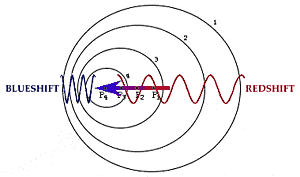|

Physics
101: Redshift and the Expanding Universe
by Pearl Tesler
Throughout
our universe
, light is bursting
from stars, bouncing off planets, diving into black holes, wandering
into nebulae, and generally going every which way. Meanwhile,
a little bit of it actually shows up here on earth.
The
light that does arrive here all seems to bear the same message:
the universe is expanding.
How
can light from the night sky tell us that the universe is growing
in size? The main clue comes from something called redshift.
Redshift
is light's version of a phenomenon we experience all the time
with sound. Have you ever noticed how the pitch of a police siren
seems to drop suddenly as the car zooms by you? As the siren approaches
you, the waves of sound are squeezed together, and you hear them
as being higher-pitched. After the car passes by, sound waves
from the receding siren are stretched apart. You hear these stretched
waves as being lower-pitched.

Follow
the car
to see a Shockwave demonstration of Doppler.
|
This
apparent change in the pitch (or frequency) of sound is called
Doppler shift. Light from distant stars and galaxies can be shifted
in much the same way.
Like
sound, light is a wave that can be described in terms of its frequency,
the number of wave peaks that pass by each second. Just like a
cosmic police car, a star zooming toward you has its light waves
squeezed together. You see these light waves as having a higher
frequency than normal. Since blue is at the high-frequency end
of the visible spectrum, we say the light from an approaching
star is shifted toward blue, or blueshifted.
Likewise,
if a star is zooming away from you, any light it emits gets stretched.
You see these stretched-out light waves as having a lower frequency.
Since red is at the low-frequency end of the visible spectrum,
we say that light from a receding star is shifted toward red,
or redshifted.

|
Imagine
you're moving to the left with this arrowhead. Light emitted
from galaxies moving toward you would be squished, making
the wavelength shorter and the light bluer. On earth, we perceive
the light from galaxies moving away from us (as it appears
almost all galaxies are) . . . . as being somewhat stretched,
with longer wavelengths that make it look redder.
|
The
amount of the shift depends on the speed of the star, relative
to you. For a moving object to create an appreciable redshift
or blueshift requires some pretty serious speeds. To get just
a 1% change in the frequency of light, a star has to be moving
1,864 miles per second. For a blue lightbulb to look red, it would
have to be flying away from you at 3/4 of the speed of light.
Studying
light from galaxies throughout our universe, astronomers have
noticed something surprising: almost all of it is redshifted.
In fact, not only is it redshifted, galaxies that are farther
away are more redshifted than closer ones. So it seems that not
only are all the galaxies in the universe moving away from us,
the farther ones are moving away from us the fastest.
On
first glance, this seems to put us at ground zero of a major cosmological
exodus. . .what is it, our

Show yourself
why it always seems
that we're the center of the universe. (requires Shockwave
Flash)
|
breath?
In fact, we aren't really at the center of the expansion. In an
expanding universe, anyone standing anywhere in the universe would
see everything as moving away, or redshifted.
What
puzzles astronomers most now is not that the universe is expanding,
but that the rate of this expansion seems to be increasing. Using
data from the Hubble Space Telescope, astronomers hope to be able
to figure out the likely fate of our universe: Will it expand
forever, or will the expansion reverse and cause the universe
to collapse back into another
Big
Bang
? Stay tuned.

For a more
in-depth look at how astronomers can use redshift to determine
speed and other properties of celestial objects, check out this
presentation from NOVA's "
Runaway
Universe
" Web site.
|
![]()
![]()